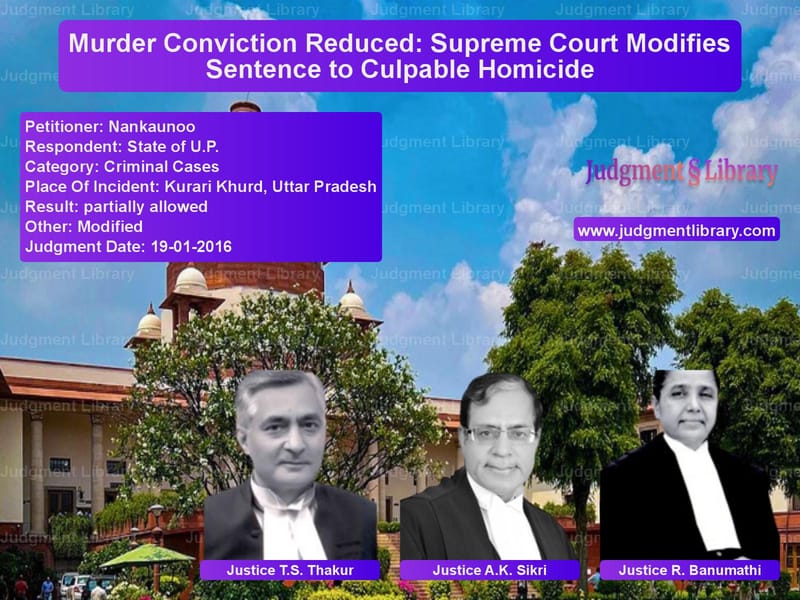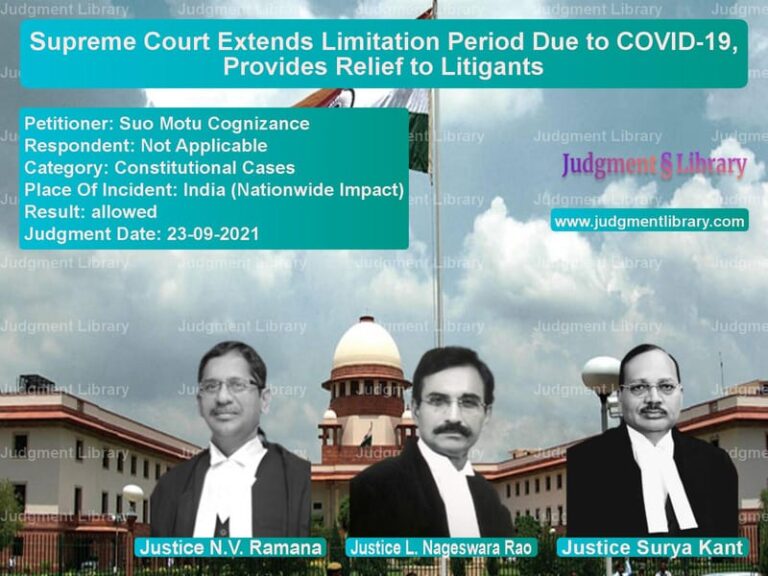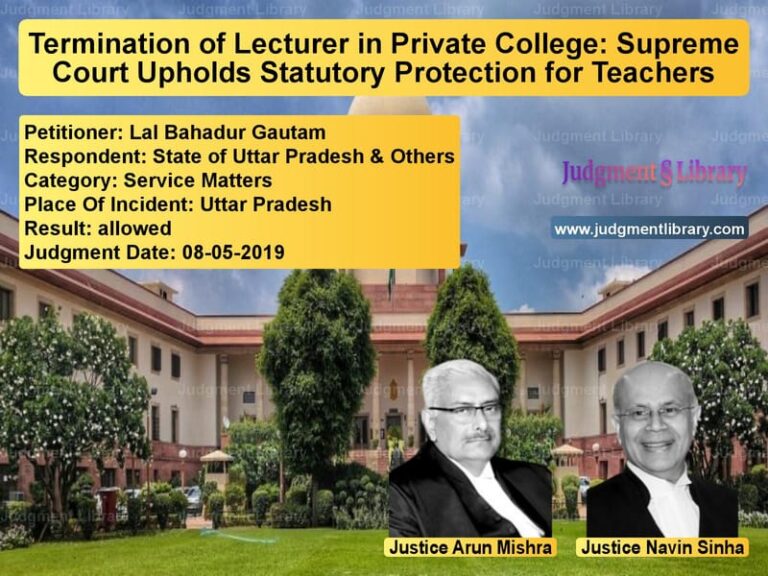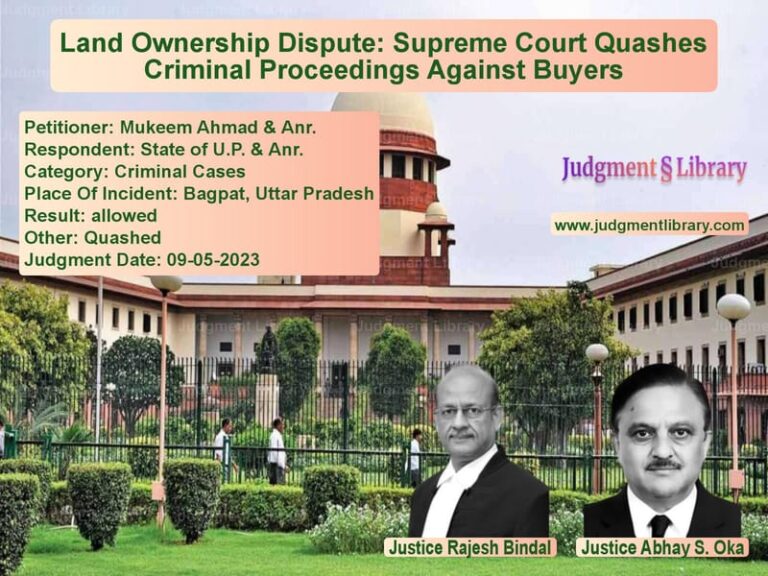Murder Conviction Reduced: Supreme Court Modifies Sentence to Culpable Homicide
The case of Nankaunoo v. State of U.P. is a significant ruling where the Supreme Court modified a murder conviction under Section 302 IPC to culpable homicide not amounting to murder under Section 304 Part 1 IPC. The ruling highlights the importance of assessing intent, the nature of injuries, and whether the act was sufficient in the ordinary course of nature to cause death.
Background of the Case
The incident occurred on February 18, 1981, in Kurari Khurd Market, where the appellant, Nankaunoo, visited the barber shop of the deceased, Chhedi Lal. An argument broke out when Nankaunoo demanded a haircut, insisting on preference over other customers. Chhedi Lal refused, leading to a heated exchange. Later that evening, at around 6:00 p.m., when Chhedi Lal went towards a canal near the village abadi to relieve himself, the appellant confronted him with a pistol, threatening to kill him for insulting him earlier.
As Chhedi Lal tried to flee, the appellant fired a shot, hitting him on the left thigh. The incident was witnessed by multiple individuals, including Janoo (PW2), Udan (PW3), and the deceased’s father, Kishore (PW1), who were returning from their fields. The wounded Chhedi Lal was taken home and then to the police station, where an FIR was registered. However, on the way to the hospital, he succumbed to his injuries. The case was subsequently altered from Section 307 IPC (attempt to murder) to Section 302 IPC (murder).
Key Legal Issues
- Whether the act of the appellant constituted murder under Section 302 IPC or culpable homicide under Section 304 IPC.
- Whether the gunshot wound on the left thigh was sufficient in the ordinary course of nature to cause death.
- Whether the High Court was justified in upholding the conviction under Section 302 IPC.
Arguments Presented
Appellant’s Arguments
- The appellant’s counsel argued that the injury inflicted was on a non-vital organ, i.e., the left thigh, and was not intended to cause death.
- They contended that the act lacked premeditation, as it was a result of a sudden altercation between the parties.
- The prosecution had failed to prove that the injury was sufficient in the ordinary course of nature to cause death.
Prosecution’s Arguments
- The prosecution argued that the appellant had intentionally fired at the deceased, showing a clear intention to kill him.
- They asserted that the eye-witness testimony of PWs 1, 2, and 3 was credible and proved beyond doubt that the appellant was responsible for the fatal gunshot wound.
- The medical evidence corroborated the fact that the deceased died from excessive bleeding due to the gunshot wound.
Supreme Court’s Ruling
The Supreme Court modified the conviction from Section 302 IPC to Section 304 Part 1 IPC, reducing the appellant’s punishment to 10 years of rigorous imprisonment. The key observations made by the Court were:
Absence of Premeditation
- The Court noted that the altercation at the barber shop did not indicate prior planning or intent to kill.
- “The incident occurred due to a sudden dispute, and the firing appears to be a spur-of-the-moment action rather than a premeditated attack.”
Nature of the Injury
- The Court examined the medical report, which showed that the gunshot wound was on the left thigh, a non-vital organ.
- “The prosecution has not elicited from the doctors that the gunshot injury on the inner part of the left thigh caused the rupture of any important blood vessel and that it was sufficient in the ordinary course of nature to cause death.”
- The medical report indicated that the death occurred due to excessive bleeding, which, while serious, does not necessarily indicate an intention to cause death.
Legal Interpretation of Section 300 and 304 IPC
- The Court examined the distinction between murder (Section 302 IPC) and culpable homicide not amounting to murder (Section 304 IPC).
- It reiterated the principle that intention and knowledge are subjective states of mind, to be inferred from circumstances like the weapon used, the force of the attack, and the location of the injury.
- The ruling referenced Virsa Singh v. State of Punjab (1958) AIR 465, which established that for an act to be classified under Section 300 IPC, the injury inflicted must be sufficient in the ordinary course of nature to cause death.
Key Takeaways from the Judgment
- Assessment of Injury Matters: For a case to qualify as murder, the inflicted injury must be fatal in the ordinary course of nature.
- Premeditation vs. Sudden Dispute: A sudden altercation leading to an act of violence may not always qualify as murder but can be classified as culpable homicide.
- Judicial Review of Sentences: The Supreme Court ensures proportional sentencing, reducing a life term to 10 years when necessary.
Impact of the Judgment
This ruling clarifies how courts should differentiate between murder and culpable homicide:
- For Legal Practitioners: The judgment serves as a reference point for distinguishing cases under Sections 302 and 304 IPC.
- For Law Enforcement: It underscores the necessity of detailed medical reports to establish the severity of injuries.
- For the Judiciary: It highlights the importance of nuanced sentencing that considers both legal principles and mitigating factors.
Conclusion
The case of Nankaunoo v. State of U.P. sets an important precedent in criminal law by refining the distinction between murder and culpable homicide. By modifying the conviction, the Supreme Court ensured that justice was served proportionally, aligning the punishment with the intent and nature of the crime. This ruling reinforces the principle that each case must be judged on its specific facts, ensuring fairness in criminal sentencing.
Don’t miss out on the full details! Download the complete judgment in PDF format below and gain valuable insights instantly!
Download Judgment: Nankaunoo vs State of U.P. Supreme Court of India Judgment Dated 19-01-2016.pdf
Direct Downlaod Judgment: Direct downlaod this Judgment
See all petitions in Murder Cases
See all petitions in Bail and Anticipatory Bail
See all petitions in Attempt to Murder Cases
See all petitions in Judgment by T.S. Thakur
See all petitions in Judgment by A.K. Sikri
See all petitions in Judgment by R. Banumathi
See all petitions in partially allowed
See all petitions in Modified
See all petitions in supreme court of India judgments January 2016
See all petitions in 2016 judgments
See all posts in Criminal Cases Category
See all allowed petitions in Criminal Cases Category
See all Dismissed petitions in Criminal Cases Category
See all partially allowed petitions in Criminal Cases Category







